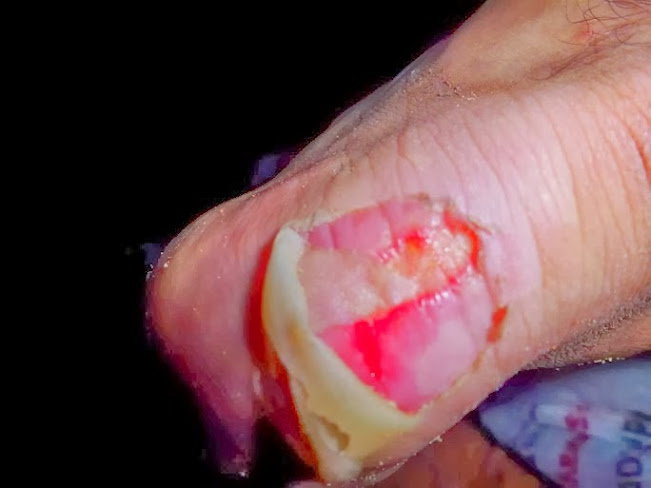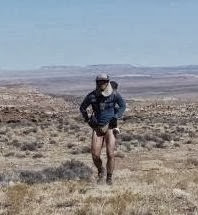“If people are constantly falling off a cliff, you could place ambulances under the cliff or build a fence on the top of the cliff. We are placing all too many ambulances under the cliff.”
~ Denis Burkitt (1911-1993)
Some of the more common hiker maladies include blisters, strains, sprains and chafing. Thankfully all of these ailments are largely preventable by taking some basic precautionary measures.
Blisters
Blisters come about because of friction. Friction is caused by ill-fitting footwear and excessive moisture. In keeping with the motto of prevention is better than cure:
Buy your Shoes too Big
-

Photo courtesy of Mike “The Gambler” Towne
Swelling: Over the course of a long hike in which you are repeatedly walking 8 hours plus per day, your feet WILL swell. This is especially true when hiking in hot conditions. Shoes that feel nice and snug in the store, will most probably feel tight and uncomfortable after a few days on the trail.
- Fit: Disregard the sales person who insists that the correct fit for hiking footwear is one finger between your heel and the back of the shoe. Two fingers are more like it. Before purchasing walk up and down stairs, run around the store and wiggle your toes vigorously. If there is any tightness whatsoever, the shoes are too small. Remember, your feet WILL swell.
Breaking In
No matter what your choice in footwear, go for at least a few hikes before embarking on a multi-day trek. Your feet need time to adapt. This especially holds true if you purchase leather boots, which may require weeks of regular wear before they feel completely comfortable.
Horses for Courses
Your choice of footwear should reflect the nature of the conditions in which you will be hiking. For example, in hotter conditions, look for lightweight and well ventilated shoes. Heavy boots in hot conditions are an invitation for blisters.
Socks
- Avoid cotton: It clings to the skin when wet, doesn’t insulate and takes longer to dry.
 Synthetic or synthetic/merino wool blend socks are ideal for hiking. They are breathable, wick moisture away from the skin and are quick drying. At the time of writing (2013) my three season (spring, summer, autumn) socks of choice are REI Merino Wool Liners (see left photo) and Wright Socks Cool Mesh.
Synthetic or synthetic/merino wool blend socks are ideal for hiking. They are breathable, wick moisture away from the skin and are quick drying. At the time of writing (2013) my three season (spring, summer, autumn) socks of choice are REI Merino Wool Liners (see left photo) and Wright Socks Cool Mesh.
- Fit: Always wear socks that fit. Too much loose material will result in friction and excessive moisture. At the other end of the spectrum, socks that are too tight can restrict circulation and cause swelling.
Beat Blisters to the Punch
- Pre-taping: If you have regular trouble spots (e.g. the back of your heels), consider taping them up before hiking.
- Hot Spot: If you feel blister developing, stop and deal with it ASAP. Options include covering it with medical tape, band aids, second skin liquid or duct tape.
- Air your feet regularly.
- Toenails: Keep them trimmed.
- Change and clean socks regularly. Any washing should be done away from water sources. Hang them to dry on the outside of your pack.
- Wash your feet regularly, either away from water sources or down stream from where people gather water.
Midday foot wash and airing | Continental Divide Trail, USA, 2012
Treatment
- Small blisters: Apply antiseptic ointment and cover with a bandaid or medical tape. Alternatively don’t do anything and let nature run its course.
- Larger blisters: If they are seriously impeding your ability to hike: 1. Clean with water or antiseptic swab; 2. Pop with a flame sterilized needle; 3. Apply an antiseptic cream/solution, and; 4. Cover with a dressing.
Sprains & Strains
After blisters, it has often struck me that the two most common hiking related ailments are sprained ankles and sore knees.
Preventative Measures
- Pre-Hike Preparation: Three elements: conditioning, strength and flexibility. Using a kickboard in the pool is a great way to improve ankle strength. The wall sit and squat are ideal exercises for increasing muscle strength around the knee area.
- Carrying a Light Pack: Makes a huge difference in minimising stress related injuries.
- Appropriate footwear: Heavy boots usually equate to heavy feet by the end of a long day. It is said that each pound (0.45kg) on your feet equates to at least five pounds (2.3kg) on your back. When your feet are dragging, you are more likely to slip or turn an ankle. See Footwear in the GEAR section.
- Don’t Do Too Much Too Soon: Think tortoise rather than hare. It is no use coming out of the gates at a million miles an hour if you haven’t done the preparation. Build up gradually, allowing your body time to adapt to the rigours of the trail. Aim at finishing the hike stronger than you started it.
On-trail Treatment
- Ankles: A slight twist, whilst a little uncomfortable, is usually fine to keep walking on. For more severe sprains, follow R.I.C.E principles as soon as practical. If you have no choice but to keep walking, cold water/snow and Ibprofun can help reduce pain and swelling. Raising the feet during breaks and whilst sleeping (ie. sleep on a slight slope with your head pointing down hill) can also help.
- Knees: If you have a history of knee pain, try to take it easy on the downhills. Trekking poles may be a good option.
Chafing
Never pleasant. Most common in the groin and inner thigh area, although can occur pretty much anywhere that skin is rubbing against sweat soaked clothes or pack.

SW Horseshoe Inner-thigh Blues (see story below) | Muley Twist Canyon, UT, 2012
Prevention
- Maintenance: Regular washing of the crotch, rear and armpit areas. Be sure to practice this ritual away from water sources, both for the benefit of the environment and the sensibilities of your fellow hikers. If water is scarce, bring along baby wipes.
- Swimming: Supplement regular washes of the “essentials”, with as much swimming as possible. Before jumping in, always be sure to give yourself a quick “pre-clean” if you have been using sunscreen or insect repellent.
- Clean clothes: If hiking in hot and/or humid conditions, I try and give my hiking shirt and shorts a quick rinse every couple of days. Less frequently in cooler weather.
- No Undies: Go commando. I have no hard scientific evidence to back it up, but I’m sure the extra ventilation must help.
- The Extreme: Generally speaking, men tend to suffer chafe problems more than women. Therefore, taking the commando concept one step further, guys could always try a hiking kilt. I have actually met quite a few long distance hikers who, having suffered from chronic chafing, swear that kilts are the way to go. Generations of Scottish Highlanders can’t all be wrong, can they?
Treatments
 Bag Balm – The mother of all chafe treatments. Also comes in handy if by some chance you need to lube up a few cow udders during your journey.
Bag Balm – The mother of all chafe treatments. Also comes in handy if by some chance you need to lube up a few cow udders during your journey.
- Hydrocortisone cream
- Vaseline
- Medicated powders such as Prantal or Gold Bond.
- Regular walking – thighs, groins, etc. are no different to feet; they will toughen up the more you use them.
Case Study: Chafe Karma or “Stuck inside of Utah, with the Inner-thigh Blues Again”
In more than two decades and 40,000 plus miles of hiking I had never had a serious case of chafe.
Indeed, I occasionally made fun of hiking buddies who moaned and groaned about tender thighs or raw behinds. With a wry grin, I would suggest they reevaluate their on-trail hygiene and wiping techniques. Alas, chafe karma well and truly caught up with me during  the Southwestern Horseshoe in 2012.
the Southwestern Horseshoe in 2012.
After retiring my beloved Macpac Cross Terrain shorts, I decided to go with an old nylon pair I picked up from Target some years back.
This decision, together with the combination of sand and howling winds, left my inner thighs rawer than raw. Not being prepared for my predicament, I went through an entire tube of lip balm in search of some relief.
The malady was not alleviated until my arrival in Escalante, Utah, where I was able to obtain some Bag Balm, a salve which is generally used on cows to avoid chapped udders.